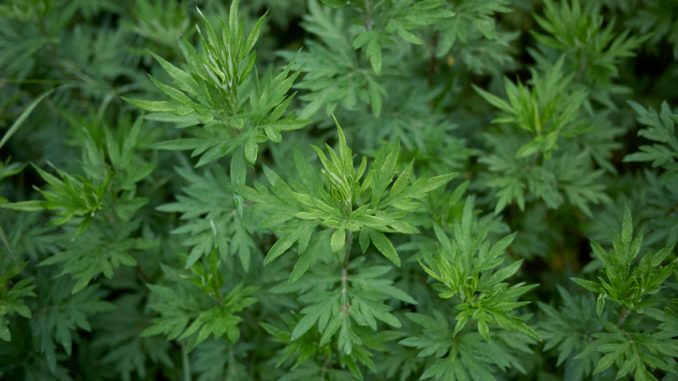
Artemisia vulgaris (Family: Asteraceae) has more common names such as mugwort or felon wort. It is known throughout northern Europe as ‘the mother of all herbs’. It grows now throughout the northern hemisphere.
It was highly regarded in by Celtic tribes, especially the druids and the Anglo-Saxons as one of nine herbs to repel poisons and toxins.
The herb also has darker meanings because of its associations with fertility rites, the old Saxon magic rites and witchcraft. Mugwort is the national plant of the Isle of Man where it is also known as ‘Bollan bane’ and is worn on the 5th July which is midsummer in the Old Julian calendar.
The Romans planted mugwort by the roadside which might explain why so much is seen on grass verges. It was placed under the foot because they undertook 20 to 30 mile route marches at times and soothed their sore feet and reduce bruising and blistering. The Greeks knew about it too as did the ancient Chinese who call it ‘moxa’. In fact, Wiilliam Coles writing in The Art of Simpling of 1656 claims ‘if a footman take mugwort and put it into his shoes in the morning he may goe forty miles before noon and not be weary’.
The leaves of the plant are used. It produces a bitter, aromatic and tonic herb concoction.
The herb has culinary value. It is used to garnish eel and carp, and is also found in stuffings for various poultry especially duck and goose.
Componentry
The essential oil makes up 0.1 to 1.4 percent of the leaf weight.
The main compounds in the essential oil extracted from the leaves are 1,8-cineole, β-thujone, caryophyllene, germacrene D, and camphor (Govindaraj et al., 2008). Polar extracts of this plant contain mainly phenolic compounds, including flavonoids (isoquercitrin, quercitrin, quercetin, luteolin, and kaempferol), hydroxycinnamic acids (gentisic, caffeic, p-coumaric, and ferulic acids), and several quinic acid derivatives (3-caffeoylquinic, chlorogenic, 5-feruloylquinic, 3,4-dicaffeoylquinic, 3,5-dicaffeoylquinic, 1,5-dicaffeoylquinic, 1,3-dicaffeoylquinic, 1,4-dicaffeoylquinic and 4,5-dicaffeoylquinic acids) (Melguizo-Melguizo et al., 2014).
Uses
A digestive stimulant where it raises appetite, diuretic and serves as a nerve tonic. It raises perspiration for cooling purposes. It also protects the liver if taken as an infusion, stimulates the uterus and causes the death of intestinal parasites including tapeworms, threadworms and roundworms.
In Chinese medicine, the leaves are made into a compress to control uterine bleeding and threatened miscarriage. Sometimes, it is burnt very briefly on the skin to warm the acupuncture points in cases of internal cold. In Ayurvedic medicine, it is used for protecting the female reproductive system, treating nervous complaints and as an anti-fungal agent.
It is never to be given to pregnant or lactating women.
It makes an excellent mosquito repellent especially against the species Aedes aegypti which carries Yellow Fever.
There is some clinical evidence to support its efficacy. It appears to protect against carbon tetrachloride induced hepatosis in mice which were attributed to a mix of antioxidant and immunomodulation activities.
References
Govindaraj, S., Kumari, B. D. R., Cioni, P. L., & Flamini, G. (2008). Mass propagation and essential oil analysis of Artemisia vulgaris. Journal of Bioscience and Bioengineering, 105(3), pp. 176-183
Melguizo-Melguizo, D., Diaz-de-Cerio, E., Quirantes-Piné, R., Švarc-Gajić, J., & Segura-Carretero, A. (2014). The potential of Artemisia vulgaris leaves as a source of antioxidant phenolic compounds. Journal of Functional Foods, 10, pp. 192-200.
Leave a Reply